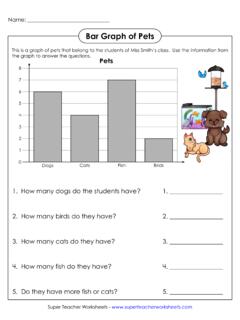Transcription of HOW POWERFUL ARE GRAPH NEURAL NETWORKS
1 Published as a conference paper at ICLR 2019 HOWPOWERFUL AREGRAPHNEURALNETWORKS?Keyulu Xu Hu Stanford LeskovecStanford NEURAL NETWORKS (GNNs) are an effective framework for representationlearning of graphs. GNNs follow a neighborhood aggregation scheme, where therepresentation vector of a node is computed by recursively aggregating and trans-forming representation vectors of its neighboring nodes. Many GNN variants havebeen proposed and have achieved state-of-the-art results on both node and graphclassification tasks. However, despite GNNs revolutionizing GRAPH representationlearning, there is limited understanding of their representational properties andlimitations. Here, we present a theoretical framework for analyzing the expressivepower of GNNs to capture different GRAPH structures.
2 Our results characterizethe discriminative power of popular GNN variants, such as GRAPH ConvolutionalNetworks and GraphSAGE, and show that they cannot learn to distinguish certainsimple GRAPH structures. We then develop a simple architecture that is provablythe most expressive among the class of GNNs and is as POWERFUL as the Weisfeiler-Lehman GRAPH isomorphism test. We empirically validate our theoretical findingson a number of GRAPH classification benchmarks, and demonstrate that our modelachieves state-of-the-art with GRAPH structured data, such as molecules, social, biological, and financial NETWORKS ,requires effective representation of their GRAPH structure (Hamilton et al., 2017b). Recently, therehas been a surge of interest in GRAPH NEURAL Network (GNN) approaches for representation learningof graphs (Li et al.)
3 , 2016; Hamilton et al., 2017a; Kipf & Welling, 2017; Velickovic et al., 2018;Xu et al., 2018). GNNs broadly follow a recursive neighborhood aggregation (or message passing)scheme, where each node aggregates feature vectors of its neighbors to compute its new featurevector (Xu et al., 2018; Gilmer et al., 2017). Afterkiterations of aggregation, a node is representedby its transformed feature vector, which captures the structural information within the node sk-hopneighborhood. The representation of an entire GRAPH can then be obtained through pooling (Yinget al., 2018), for example, by summing the representation vectors of all nodes in the GNN variants with different neighborhood aggregation and GRAPH -level pooling schemes havebeen proposed (Scarselli et al., 2009b; Battaglia et al.
4 , 2016; Defferrard et al., 2016; Duvenaud et al.,2015; Hamilton et al., 2017a; Kearnes et al., 2016; Kipf & Welling, 2017; Li et al., 2016; Velickovicet al., 2018; Santoro et al., 2017; Xu et al., 2018; Santoro et al., 2018; Verma & Zhang, 2018; Yinget al., 2018; Zhang et al., 2018). Empirically, these GNNs have achieved state-of-the-art performancein many tasks such as node classification, link prediction, and GRAPH classification. However, thedesign of new GNNs is mostly based on empirical intuition, heuristics, and experimental trial-and-error. There is little theoretical understanding of the properties and limitations of GNNs, and formalanalysis of GNNs representational capacity is limited. Equal contribution. Work partially performed while in Tokyo, visiting Prof. Ken-ichi Kawarabayashi.
5 Work partially performed while at RIKEN AIP and University of [ ] 22 Feb 2019 Published as a conference paper at ICLR 2019 Here, we present a theoretical framework for analyzing the representational power of GNNs. Weformally characterize how expressive different GNN variants are in learning to represent and distin-guish between different GRAPH structures. Our framework is inspired by the close connection betweenGNNs and the Weisfeiler-Lehman (WL) GRAPH isomorphism test (Weisfeiler & Lehman, 1968), apowerful test known to distinguish a broad class of graphs (Babai & Kucera, 1979). Similar to GNNs,the WL test iteratively updates a given node s feature vector by aggregating feature vectors of itsnetwork neighbors. What makes the WL test so POWERFUL is its injective aggregation update that mapsdifferent node neighborhoods to different feature vectors.
6 Our key insight is that a GNN can have aslarge discriminative power as the WL test if the GNN s aggregation scheme is highly expressive andcan model injective mathematically formalize the above insight, our framework first represents the set of featurevectors of a given node s neighbors as amultiset, , a set with possibly repeating , the neighbor aggregation in GNNs can be thought of as anaggregation function over themultiset. Hence, to have strong representational power, a GNN must be able to aggregate differentmultisets into different representations. We rigorously study several variants of multiset functions andtheoretically characterize their discriminative power, , how well different aggregation functions candistinguish different multisets. The more discriminative the multiset function is, the more powerfulthe representational power of the underlying main results are summarized as follows:1)We show that GNNs areat mostas POWERFUL as the WL test in distinguishing GRAPH )We establish conditions on the neighbor aggregation and GRAPH readout functions under whichthe resulting GNN isas POWERFUL asthe WL )We identify GRAPH structures that cannot be distinguished by popular GNN variants, such asGCN (Kipf & Welling, 2017) and GraphSAGE (Hamilton et al.
7 , 2017a), and we preciselycharacterize the kinds of GRAPH structures such GNN-based models can ) We develop a simple NEURAL architecture, GRAPH Isomorphism Network (GIN), and show thatits discriminative/representational power is equal to the power of the WL validate our theory via experiments on GRAPH classification datasets, where the expressive powerof GNNs is crucial to capture GRAPH structures. In particular, we compare the performance of GNNswith various aggregation functions. Our results confirm that the most POWERFUL GNN by our theory, , GRAPH Isomorphism Network (GIN), also empirically has high representational power as it almostperfectly fits the training data, whereas the less POWERFUL GNN variants often severely underfit thetraining data. In addition, the representationally more POWERFUL GNNs outperform the others by testset accuracy and achieve state-of-the-art performance on many GRAPH classification begin by summarizing some of the most common GNN models and, along the way, introduce ournotation.
8 LetG= (V,E)denote a GRAPH with node feature vectorsXvforv V. There are two tasksof interest: (1)Node classification, where each nodev Vhas an associated labelyvand the goal isto learn a representation vectorhvofvsuch thatv s label can be predicted asyv=f(hv); (2)Graphclassification, where, given a set of graphs{G1,..,GN} Gand their labels{y1,..,yN} Y, weaim to learn a representation vectorhGthat helps predict the label of an entire GRAPH ,yG=g(hG). GRAPH NEURAL use the GRAPH structure and node featuresXvto learn a representa-tion vector of a node,hv, or the entire GRAPH ,hG. Modern GNNs follow a neighborhood aggregationstrategy, where we iteratively update the representation of a node by aggregating representationsof its neighbors. Afterkiterations of aggregation, a node s representation captures the structuralinformation within itsk-hop network neighborhood.
9 Formally, thek-th layer of a GNN isa(k)v=AGGREGATE(k)({h(k 1)u:u N(v)}), h(k)v=COMBINE(k)(h(k 1)v,a(k)v),( )whereh(k)vis the feature vector of nodevat thek-th iteration/layer. We initializeh(0)v=Xv, andN(v)is a set of nodes adjacent tov. The choice of AGGREGATE(k)( )and COMBINE(k)( )in2 Published as a conference paper at ICLR 2019 GraphRooted subtree2 WL test iterationsMultisetGNN structuresFigure 1:An overview of our theoretical panel: rooted subtree structures(at the blue node) that the WL test uses to distinguish different graphs. Right panel: if a GNN saggregation function captures thefull multisetof node neighbors, the GNN can capture the rootedsubtrees in a recursive manner and be as POWERFUL as the WL is crucial. A number of architectures for AGGREGATE have been proposed.
10 In the poolingvariant of GraphSAGE (Hamilton et al., 2017a), AGGREGATE has been formulated asa(k)v= MAX({ReLU(W h(k 1)u), u N(v)}),( )whereWis a learnable matrix, and MAX represents an element-wise max-pooling. The COMBINE step could be a concatenation followed by a linear mappingW [h(k 1)v,a(k)v]as in GraphSAGE. InGraph Convolutional NETWORKS (GCN) (Kipf & Welling, 2017), the element-wisemeanpooling isused instead, and the AGGREGATE and COMBINE steps are integrated as follows:h(k)v= ReLU(W MEAN{h(k 1)u, u N(v) {v}}).( )Many other GNNs can be represented similarly to Eq. (Xu et al., 2018; Gilmer et al., 2017).For node classification, the node representationh(K)vof the final iteration is used for prediction. Forgraph classification, the READOUT function aggregates node features from the final iteration toobtain the entire GRAPH s representationhG:hG= READOUT({h(K)v v G}).
![arXiv:0706.3639v1 [cs.AI] 25 Jun 2007](/cache/preview/4/1/3/9/3/1/4/b/thumb-4139314b93ef86b7b4c2d05ebcc88e46.jpg)

![arXiv:1301.3781v3 [cs.CL] 7 Sep 2013](/cache/preview/4/d/5/0/4/3/4/0/thumb-4d504340120163c0bdf3f4678d8d217f.jpg)
![@google.com arXiv:1609.03499v2 [cs.SD] 19 Sep 2016](/cache/preview/c/3/4/9/4/6/9/b/thumb-c349469b499107d21e221f2ac908f8b2.jpg)








![Pietro Lio` arXiv:1710.10903v3 [stat.ML] 4 Feb 2018](/cache/preview/6/9/b/8/0/d/4/8/thumb-69b80d48100630b31293189afc348f88.jpg)



